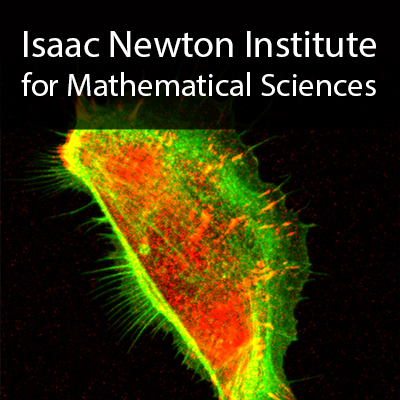Actin cortex mechanics in cell migration without focal adhesions
Duration: 1 hour 12 mins
Share this media item:
Embed this media item:
Embed this media item:
About this item

| Description: |
Paluch, E
Monday 13th July 2015, 13:30 - 14:30 |
|---|
| Created: | 2015-07-15 18:38 |
|---|---|
| Collection: | Coupling Geometric PDEs with Physics for Cell Morphology, Motility and Pattern Formation |
| Publisher: | Isaac Newton Institute |
| Copyright: | Paluch, E |
| Language: | eng (English) |
| Distribution: |
World
|
| Explicit content: | No |
| Aspect Ratio: | 16:9 |
| Screencast: | No |
| Bumper: | UCS Default |
| Trailer: | UCS Default |
| Abstract: | The shape of animal cells is primarily determined by the cellular cortex, a thin network of actin filaments and myosin motors that lies directly underneath the plasma membrane. Cell shape changes are driven by controlled changes in the physical properties of the cortex, which arise from the microscopic architecture, composition and dynamics of the cortical network. We investigate how the mechanical properties of the cortex are controlled at the molecular level, and how changes in these properties drive cell deformation. We have developed methods to investigate the spatial organisation of the cortex at the microscopic scale and are exploring how network organisation and the spatial distribution of motor proteins determine cortical tension. A precise spatial control of cortex tension and contractility is essential during cell shape changes. For example, during cell migration, contractility gradients towards the back of the cell have been involved in promoting cell polarization and the forward movement of the cell body. We are studying the control and function of cortical contractile tension during bleb-based migration of non adherent cells in 3-dimensional confinement. We could show that in such cells, a sustained rearward cortical flow is sufficient to drive persistent cell motion in confinement, even in the absence of specific substrate adhesions. We show that the non-adherent cells use a friction-based migration mechanism, which relies on forces several orders of magnitude smaller than adhesion-based migration. Such focal adhesion-independent locomotion may be advantageous for cells crossing multiple tissues, as it does not require the expression of tissue-specific receptors. Related Links
http://www.ucl.ac.uk/lmcb/research-group/ewa-paluch-research-group - lab website |
|---|---|
Available Formats
| Format | Quality | Bitrate | Size | |||
|---|---|---|---|---|---|---|
| MPEG-4 Video | 640x360 | 1.95 Mbits/sec | 1.03 GB | View | Download | |
| WebM | 640x360 | 757.7 kbits/sec | 399.57 MB | View | Download | |
| iPod Video | 480x270 | 526.04 kbits/sec | 277.41 MB | View | Download | |
| MP3 | 44100 Hz | 251.82 kbits/sec | 132.80 MB | Listen | Download | |
| Auto * | (Allows browser to choose a format it supports) | |||||

